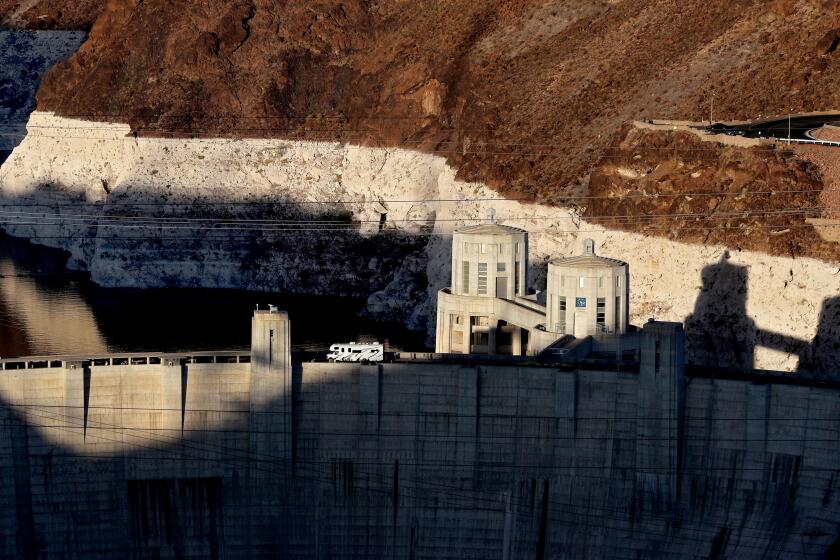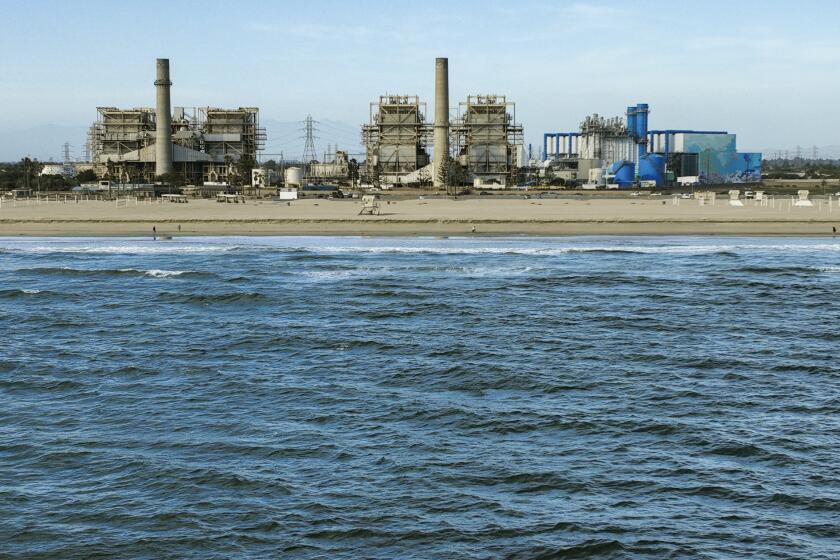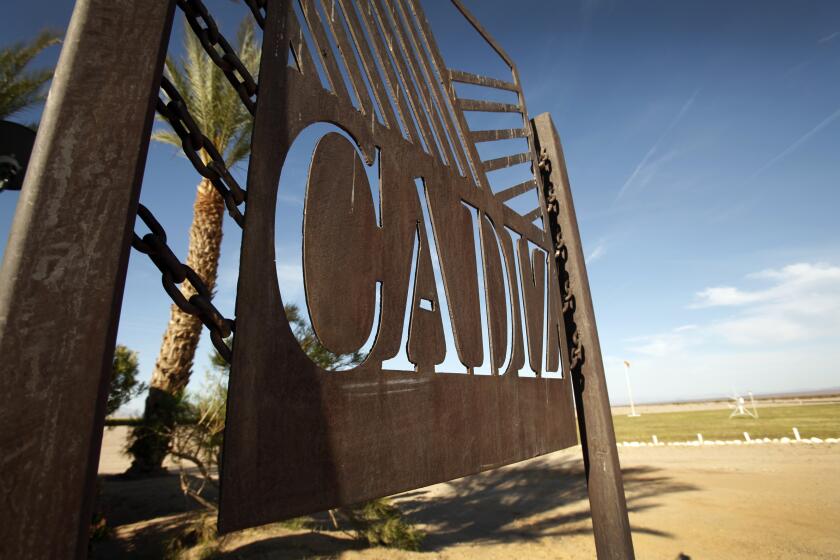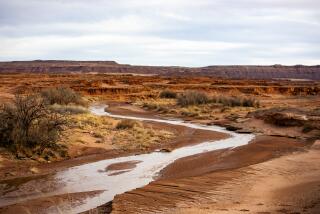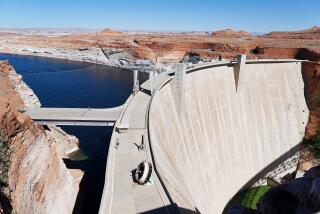Column: The fight over the Colorado River is a 100-year-old interstate grudge match
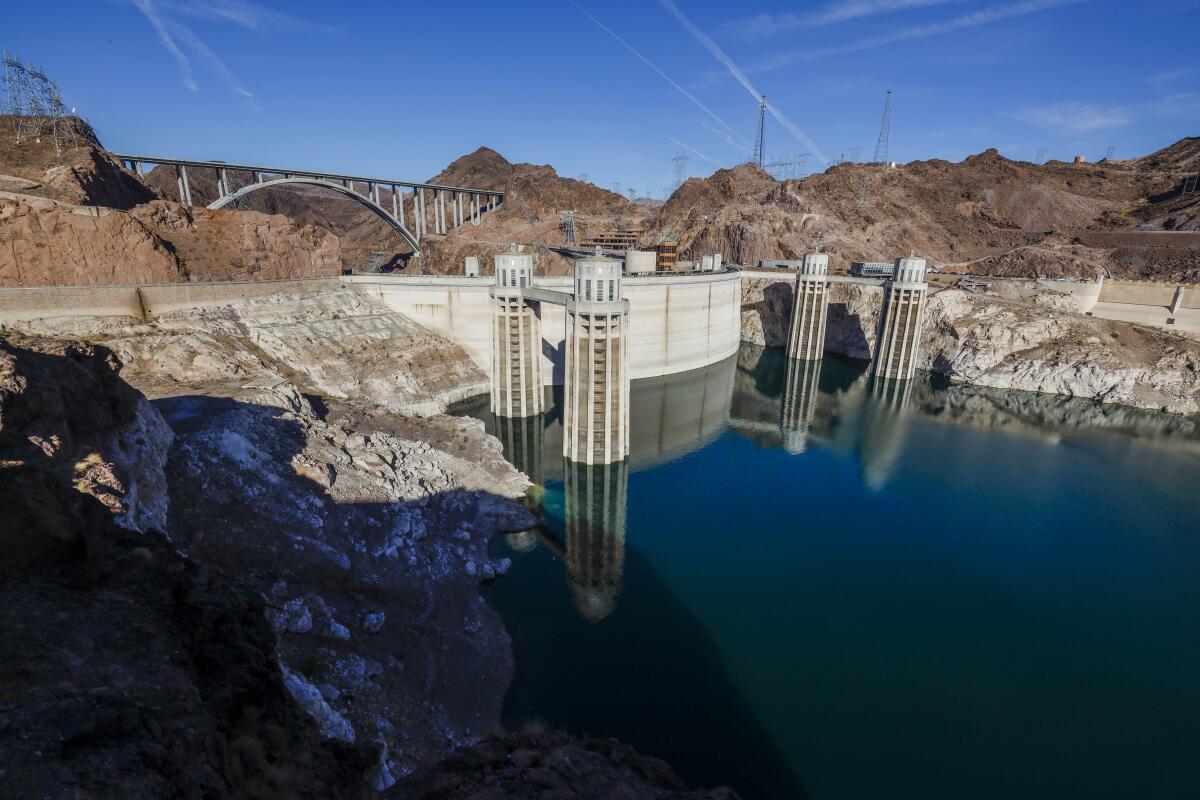
Arizona was girding for war with California over the Colorado River.
The year was 1934 and the place was the construction site of Parker Dam, downstream from the nearly completed Hoover Dam.
Arizona Gov. Benjamin Baker Moeur, irked that a federally approved interstate compact had awarded California more water from the Colorado than he thought it deserved, dispatched a squad of National Guard troops to the river on a ferryboat to block the new dam’s construction.
California’s intrastate agreements are not well understood outside of California.
— J.B. Hamby, Colorado River Board of California
The ferryboat Julia B., derisively dubbed the “flagship” of the “Arizona Navy” by a Times war correspondent assigned to cover the skirmish, promptly ran aground on a sandbar.
After Interior Secretary Harold Ickes imposed a truce between the two states, the guardsmen returned home from the war zone to be hailed as “conquering heroes.”
Get the latest from Michael Hiltzik
Commentary on economics and more from a Pulitzer Prize winner.
You may occasionally receive promotional content from the Los Angeles Times.
This encounter, bristling with Gilbert & Sullivan absurdity, only hints at the bitter animosities among the seven states of the Colorado River Basin that have simmered since they reached a compact — essentially an interstate treaty — apportioning the waters of the river in 1922.
More precisely, six of those states — Arizona, Nevada, New Mexico, Colorado, Utah and Wyoming — have viewed California with alarm, convinced that any apportionment proposal offered by the biggest and most populous state in the basin is subtly designed to ensure its domination of the river’s bounty.
Over the last century, California has fought fiercely to preserve its legally sanctioned right to 4.4 million acre-feet of Colorado River water per year. (An acre-foot, about 326,000 gallons, is enough to serve one or two households for a year.)
This conflict, born in negotiations over the seven-state compact reached in 1922 and the Boulder Canyon Project Act of 1928, which authorized the building of Hoover Dam, explains why the states failed to meet a Jan. 31 federal deadline to restructure their water rights to accommodate the demands of nearly unrestrained growth and the implacable realities of global warming.
California’s voracious appetite for Colorado River water was not necessarily an unreasonable concern in 1922: Although only 6,000 of the 244,000 square miles of the Colorado watershed are in California, the state was by far the most thoroughly developed of the seven states, accounting for 415,000 of the 587,000 irrigated acres in the river basin north of the Mexican border.
Human demands for water from the Colorado have far outstripped what it ever could provide.
Nor is it unreasonable even now: California’s population of 39 million is nearly twice that of the other six states combined.
As my colleague Ian James reports, the impasse has resulted from California issuing its own restructuring proposal while the other six states agreed among themselves on a framework for negotiating reapportionment. California‘s plan would minimize its losses in the renegotiation while imposing more stringent reductions on Arizona and Nevada.
Reflecting the long history of contention, the Colorado River Board of California, which drafted the plan, was — shall we say? — less than entirely gracious toward the other states, especially Arizona, when it presented the proposal to the Interior Department.
Noting that California had worked for years to reach shortage-sharing agreements among its own competing agricultural, urban and environmental stakeholders, board Chairman J.B. Hamby wrote that “California’s intrastate agreements are not well understood outside of California.”
Just as California found ways to “live within its legally designated water rights,” Hamby continued, “so too may the state of Arizona be required to make similar arrangements to live within its available Colorado River water supplies.”
Even more pointedly, Hamby maintained that the failure to reach a seven-state consensus would mean that the “Law of the River” would prevail — that is, the compact, the Boulder Canyon Act, and subsequent court rulings and other agreements that have governed apportionment up to now, including California’s 4.4-million-acre-foot guarantee.
That’s a position the other states consider to be unduly legalistic, given the changes in the Colorado watershed wreaked by growth and global warming over the last century.
It’s worth going back in time to revisit the origins of the interstate friction. The impetus for the giant dam on the Colorado came from California farmers in the Imperial Valley, whose livelihoods had been almost destroyed by a flood in 1905-06 caused by the incompetent construction of a canal to bring irrigation water west from the river.
A desalination project in Huntington Beach is the wrong idea in the wrong place at the wrong time.
Building a dam for flood control and irrigation would plainly be impossible unless the seven states of the basin could agree on how to divide up the water. Supervision of the contentious negotiations was placed in the hands of then-Commerce Secretary Herbert Hoover, who was thought to be sufficiently tough-minded to bring the states to heel.
In the event, Hoover struggled with the task. The main stumbling block during negotiations in Santa Fe, N.M., was California’s insistence that a guarantee of a dam on the lower Colorado be part of the compact, a condition none of the other states would accept.
Finally, Hoover summoned the California delegation to his hotel room to upbraid them crisply for their “outrageous, scandalous” demand. He threatened to “disband this conference, announce that Boulder Dam project is dead, and that you are the people who killed Cock Robin.”
To his dismay, the Californians rose together and stomped out of the room — forcing Hoover to follow them out the door, pleading with them to stay. As it happened, his threat worked: The next day, the seven state delegations approved the final draft of the Colorado River Compact, along with a separate resolution urging “the early construction of works in the Colorado River to control the floods” as a nonbinding sop to California.
The Colorado River Compact would become the founding document of the Law of the River. But only six of the seven states ratified it in 1922. The lone holdout was Arizona, whose governors long cherished the belief that the compact was merely a plot to allow California to drain the river to its heart’s content.
Arizona finally ratified the compact in 1944, with an eye toward a likely postwar surge in population. It subsequently scored what seemed to be a major victory with a decision by the Supreme Court in 1963 in the epic lawsuit Arizona vs. California, which staggered to its conclusion after 11 years in the federal judicial system.
The court limited California to the 4.4 million acre-feet written into the Boulder Canyon Project Act, which had authorized the building of Hoover Dam, and guaranteed Arizona 2.8 million acre-feet a year. Yet on closer inspection this was a Pyrrhic victory at best, for the court also ruled that the sole authority to apportion surpluses and shortages from the Colorado belonged to the federal government.
Henceforth, all the conflicts over water in California and the West — between cities and farms, humid regions and desert zones, Southern and Northern California — would be adjudicated in the Washington office of the secretary of the Interior. For decades, successive Interior secretaries have tried to hand that responsibility back to the states, but almost invariably they have to step in and impose some sort of order.
That seems to be happening again. Now that the states have breached the Interior Department’s Jan. 31 deadline, the agency may have to step in to mandate a settlement.
The Cadiz water scheme has been a dead-project-walking for two decades. Biden may finally put it in the grave.
That will not be easy. Every time a solution to conflict over the Colorado seems to have been reached, it has been undone by nature and man’s handiwork. It was thought that the compact and the building of Hoover Dam would put an end to 50 years of conflict over the water of the Colorado. They did not.
The Supreme Court’s 1963 decision seemed to confirm Arizona’s claim, but five years later the state goaded the federal government into funding the Central Arizona Project, today a 336-mile system of pipelines, pumps and electric generating plants that serve some 80% of the state’s residents, putting ever more strain on its apportioned water supply.
In 2003, then-Interior Secretary Gale Norton came out to the dam to sign 24 agreements transferring water rights among various claimants — including Indian tribes, irrigation districts, Western cities and the government of Mexico. She proclaimed, “With these agreements, conflict on the river is stilled.”
That didn’t happen. The truth is that conflict on the river will never be stilled because there will always be more demand for the water than there is water. As I reported in “Colossus,” my 2010 book about the building of Hoover Dam, Hoover and his deputy, Arthur Powell Davis, connived in 1922 to exaggerate the Colorado River’s flow in order to persuade all seven states that it carried enough water to serve their interests, then and into the future.
Hoover Dam made the modern West, but also confined it in a straitjacket.
The dam’s promise of abundant water and power took the brakes off the growth of Los Angeles, San Diego, Phoenix and Denver; it encouraged farmers to complacently plant the most water-thirsty crops such as alfalfa and almonds; and it gave city dwellers the impression that they could water their lawns every day without worrying about waste.
Is there a solution to the conflict over the Colorado? Yes, but at this time it’s confounded by history and politics.
California and Arizona agriculture will have to be remade to accommodate new irrigation technologies and a shift to less thirsty crops. Urbanites will have to step up their conservation and recycling efforts. The states will have to recognize their shared interests in fairly distributing a shrinking resource.
And federal officials will have to work toward a settlement that every interest group finds acceptable. Wish them luck.
More to Read
Get the latest from Michael Hiltzik
Commentary on economics and more from a Pulitzer Prize winner.
You may occasionally receive promotional content from the Los Angeles Times.
